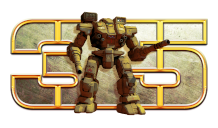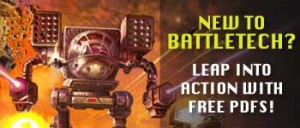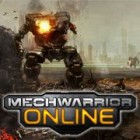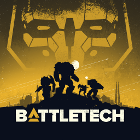- Home
- New To BattleTech?
- MUL
- Forums
- News
- Books
- Shrapnel
- Universe
- Downloads
- Characters
- Community
- Errata
- Links
- Gallery
RULES SUMMARY
Before the Event
- All Players will be randomly seeded into ’Mech Selection order.
- If participating in the Grand Melee, choose 1 Heavy Clan OmniMech with an adjusted BV2 (after Piloting and Gunnery; all G/P scores start at 4/5) of 2800 BV2 or less.
- Each player, called in order, will select a ’Mech/Pilot combination from the table, and receive their Record Sheet and grease pencil.
- The Player’s ’Mech and Record Sheet are hereafter referred to as a “Mech Pool”. The MechWarrior Skills and any Special Abilities that are selected during the selection process stay with the player, and may be transferred from ’Mech to ’Mech within the player’s pool as the tourney progresses.
At the Event
- Players are randomly seeded.
- Each player makes a 2d6 roll to determine Hunter/Hunted. High roll is the Hunter. The Hunter chooses the ’Mechs of both pilots that will be fighting in that round. He must select his ’Mech from his available ’Mech Pool, and his opponent’s ’Mech from his opponent’s ’Mech Pool.
- The Hunted chooses 2 Map Sheets and lays them out. He chooses his Home Edge. The Hunter deploys opposite the Hunted.
- Play the game. Each player gets 1 point of Edge. The first player’s ’Mech to be Destroyed or Crippled loses the match.
- The winner of the round collects his opponent’s miniature and record sheet and adds them to his ’Mech Pool.
- Turn the results in to a judge, who will then re-seed the winners to fight the next round.
FULL RULES
The 2011 Classic BattleTech Bloodname Tournament is a single-elimination tournament. This tournament has a maximum of 32 participants. This tournament requires 4, 8, 16, or 32 participants to avoid one or more players receiving a bye. A Grand Melee can be used if more than 32 players wish to participate, or if an odd number of players sign up (Example: 27 players sign up for the tournament. 15 slots are filled with the winners of qualifier matches, and all remaining players compete in the Grand Melee with the winner of the Melee filling the highest available slot, followed by other players until the 16 brackets are filled).
The 2011 Classic BattleTech Bloodname Tournament will be fought using the Total Warfare rules published in Total Warfare™ as well as any additions posted on ClassicBattletech.com. Weapons and rules found in Tactical Operations may not be used, unless a weapon from that source is listed upon a ’Mech Record Sheet handed out by a Tournament Official during the Trial of Bloodright only (Advanced equipment may not be used whatsoever during the Grand Melee). No Experimental rules or equipment may be used.
Note: The Auto Eject on all ’Mechs is considered Disabled.
DESIGNS AND LOGISTICS
At the tournament organizers’ discretion, the BattleMech, ProtoMech, vehicle and infantry record sheets printed from the HeavyMetal, Solaris Skunkwerks, or MegaMek Labs suites of design software may be used. It is up to an individual player’s opponent to verify that these sheets being used exactly match the designs as published in official record sheet volumes (or sourcebook) as described above. The Demo Agents in charge of the event will supply all record sheets.
Immediately prior to game play, but after both players have chosen their forces and laid out the maps, each player must declare the type of ammunition his units are carrying (LB-X cluster, Artemis IV-compatible missiles and so on). Players must clearly mark these ammunition types on their record sheets.
Note: Units may enter each tournament round with less than their full ammo complement. Players that wish to do so must declare this at the same time as they choose ammunition types and must clearly indicate on each record sheet the quantity of each kind of ammunition carried.
MAPS, LIST, GAME SET-UP, and PLAY
Legal Maps
All tournament matches will be fought using any two BattleTech mapsheets found in BattleTech Map Sets™ 2, 3, 4, 5, 6, 7, Compilation I or II, BattlePack: Fourth Succession War™ or BattleForce 2®. In addition, any Classic BattleTech mapsheets provided in subsequent Catalyst Game Labs, FASA, or FanPro LLC publications may be used.
However, due to the overwhelming impact some maps have on gameplay, the following maps may not be used during this tournament:
- Any Space Mapsheet
- All maps from the Solaris VII Boxed Set and Solaris VII: The Reaches
- Box Canyon
- Archipelago #1 & 2
- Heavy Forest #1 & 2
Additionally, no map may be flipped over to display a blank facing, except as a judge’s punishment (see “Sportsmanship”, below). Tiles from Hexpacks may not be used to modify maps.
Force Selection
Catalyst Game Labs will supply all Miniatures and Record Sheets. No player involvement in force selection is required.
Game Set-up
In the Bloodname Tournament, maps and ’Mechs are chosen according to the concepts of Hunter and Hunted. Prior to play, opposing players roll 2D6; the winner is the Hunter.
The Hunter chooses a ’Mech in his own ’Mech Pool and the ’Mech in his opponent’s ’Mech Pool that will engage during that round. As players have only a single ’Mech in their ’Mech Pool during the first round of the tournament ONLY, the Hunter will instead receive one bonus point of Edge and may deploy anywhere on the map containing his Home Edge using Hidden Unit rules (TW, pg 259).
After the Hunter makes his selections, the Hunted chooses the maps that the combat will be fought on. The Hunted picks and aligns two map sections and chooses his own “home” edge. In battles where 3-D terrain is used, the hunted chooses terrain items to be used from available items and places them in a 4’X6’ area outlined by the judge. The edge on which your forces enter the map is considered your “home” map edge; the opposite edge is your opponent’s “home” map edge. Each BattleMech may move onto the board using Walking, Running or Jumping movement with the first full hex on the map being the units starting point for the Movement Phase. In tournament play; only full hexes are considered legal for use.
Players may not move into, through, or end their movement in a half hex; units that do so (either voluntarily or involuntarily) are considered destroyed and will be removed from play.
Note: Some maps contain entire hexrows that constitute prohibited terrain for some units; if prohibited terrain blocks a unit from entering the game, that unit may enter on the closest available hexrow of legal terrain.
When joining two maps, joined half-hexes sometimes contain different terrain. In such cases, the entire hex is considered to be one single type of terrain, based on the predominant underlying terrain. Compare the two different kinds of terrain to the following list: 1.) hill, 2.) water, 3.) sub-level, 4.) clear; the entire hex is considered to be the terrain with the lowest number. If two half-hexes with different hill levels are placed together, the entire hex is considered to be of the higher of the two levels. Additionally, if woods and/or pavement are in either of the half-hexes, and the underlying terrain is not water, the hex is also considered to be wooded and/or paved. Finally, if the half hexes contain both light and heavy woods, the entire hex is considered to be heavy woods.
Bridges are considered to be indestructible and may hold any amount of mass.
Note that unlike in the Grand Melee, physical attacks are not permitted during the Trial of Bloodright.
Seeding and Round Length
The judges will choose opponent pairs by randomly assigning players to each other as they register. The tournament will then proceed using standard single-elimination rules; the winners move on to the next round while the losers are eliminated. If an uneven number of players is registered, the judges will assign a proxy player—a judge or another player of their choosing. This proxy player may not advance to the semi-final or final rounds. If both combatants are destroyed at the end of a match, the player who would have been the winner’s next opponent will receive a bye for the next round.
The judges will determine the length of each round. We recommend that no round exceed one (1) hour, and that there be a break between each round.
In the event of a 3-way fight during the final round of the tournament, the judges may, at their discretion (ie, time allowing) settle the matter in one of two ways.
- They may demand a 3-way fight in which each player must “hunt” the player seated next to them. All 3 players roll 2d6 – the high roller selects the ’Mechs of all three combatants, the second highest roll selects the mapsheets (although judges will place ’Mechs in their starting positions), and the lowest roll will select whether he will hunt the player to his right or to his left (thus deciding which direction the circle will travel). Once one player has been knocked out, the game immediately reverts to a normal Trial and the winner is the last man standing.
- The three players are randomly re-seeded and each possible pairing will play a game of “Speed BattleTech” as per the standard Trial format (hunter and hunted, etc). Seeds 1&2 will face one another, then Seeds 2&3, then Seeds 1&3. The two players with the most wins will face one another for the final bout. Speed BattleTech limits each player to 20 seconds per movement phase, and 1 minute per firing phase. Failure to complete movement results in a stationary (though not immobile) ’Mech for the turn, and failure to complete shooting results in all unresolved shots automatically missing (ammunition is still burned and heat is still accumulated for each weapon that does not fire). Time is stopped to resolve skidding, critical hit effects and falls. A stopwatch-equipped judge will keep time. Each round of Speed BattleTech may last no more than 20 minutes. Players who deliberately, in the judge’s estimation, “play the clock” by delaying their actions will run afoul of the Sportsmanship Penalties (described below). The final bout of the tournament will not be run under Speed BattleTech rules.
Edge
Each player has one “Edge” point per round of the Trial.
“Edge” can be used to force a re-roll of the dice at any point during the game: to-hit rolls, piloting skill rolls, hit location rolls and any other roll of the dice are all fair game, as long as the player spending Edge is the player who actually made the roll in the first place (for example, Edge may not be spent to force a re-roll on another player’s successful Piloting Skill Roll). Edge can only force the most recent roll of the dice to be re-rolled, not a prior roll; for example, a player cannot decide to reroll the to-hit roll for the second weapon he fired after making to-hit rolls for four other weapons.
Victory Conditions
If player concedes the round he is currently playing, whether because he has to leave early or he no longer wishes to participate in that round, his ’Mech is considered destroyed.
At the end of each round, the winner of each game will be the player whose BattleMech is not destroyed. See page 134 of Total Warfare™ for the definition of a destroyed ’Mech. If both ’Mechs remain operational—or both ’Mechs are destroyed in the same turn—the winner will be the person who inflicted the most damage, according to the ruling of the judges.
GRAND MELEE
The Classic BattleTech Grand Melee tournament is a free-for-all tournament that can accommodate any number of players.
Each player chooses a canon heavy OmniMech using the Total Warfare rules, with a Clan technology base. These ’Mechs are limited to a maximum of 2800 BV2 after MechWarrior skills have been taken into account. This is a cap, not a floor, as described above. Custom configurations are disallowed.
Players should, if at all possible, provide their own miniatures and record sheets for the Grand Melee. Laminated sheets and grease pencils are disallowed.
The judge of the Grand Melee tournament should use whatever mechanic he deems necessary to ensure a random placement of all units. Units are placed at the very edge of the board, at an equal distance from the other units, in the first full hex of the map edge.
The judges determine the length of the Grand Melee tournament. Keep in mind that the winner of the Grand Melee tournament fills the final slot in the Bloodname Tournament, and schedule both tournaments accordingly.
The number of mapsheets used depends upon the number of players involved in the tournament and is determined by the judges. We recommend four (4) mapsheets or a number of mapsheets equal to half the number of players. Alternatively, judges may set up the battlefield using terrain and a minimum of a 4″x6″ playing mat.
If a player concedes, whether because he has to leave early or he no longer wishes to participate in that round, his ’Mech is considered destroyed.
Because of the potential number of players involved in the Grand Melee, the judge is responsible for fairly determining Initiative. For example, the judge may create two identical stacks of numbered cards before coming to the tournament table. Prior to game play, the judge gives one card from a single stack to each participant in the Grand Melee, and then removes the same unused numbers from both stacks. He then shuffles the second set of cards and draws the top card, announcing the number drawn. The player with the corresponding number moves his ’Mech. After each turn, the judge reshuffles the numbered cards and play proceeds in the same manner.
Note: The judge may also use this system for initial placement of units. Judges also should time each player’s move to give each player equal time and to keep the game moving. We recommend no longer than one (1) minute per player.
Every Clansman who enters the Grand Melee has one goal in mind: to be the last standing. Winning the Grand Melee will gain him the final slot in the Bloodname Tournament, and gives him the opportunity to earn a Bloodname. Because a Clansman can win no higher honor than a Bloodname, there are no friends, no alliances and no holding back once the Grand Melee has begun. Physical attacks, then, are explicitly allowed during the Grand Melee (while they are not during the Trial of Bloodright). If, at any time during the Grand Melee tournament, the judges feel that a player or players are not playing by the spirit of this tournament – for example, teaming up with friends and not firing on each other, not firing on available targets, and so on – the judge can enforce the following rules to help simulate the Clan mind set in the Grand Melee tournament:
Each player MUST fire every turn on a target to which he has a valid LOS, under the following two conditions:
- A player does not have to fire any weapons that use ammo.
- A player does not have to overheat his OmniMech when firing. However, he must come as close as possible—including the heat generated during the Movement Phase—to the maximum heat dissipation capabilities of his OmniMech.
At the end of the Grand Melee tournament, the winner is the player whose BattleMech is not destroyed. See page 134 of Total Warfare™, for the definition of a destroyed ’Mech. If more than one ’Mech remains operational, the winner is the person who inflicted the most damage, according to the ruling of the judges. Larger tournaments, such as those held at the Origins and GenCon conventions, may require modifications to that rule at the judge’s discretion.
MISCELLANEOUS TOURNAMENT RULES
Unless otherwise noted, players may not use sheet protectors and accompanying dry erase/grease markers. Sheets should be marked legibly so that the judges may review the record sheets if necessary. Opponents have the right to view each other’s record sheets.
Players must use standard six-sided dice with pips or numbers when playing tournaments. No specialty dice, such as The Armory’s BattleTech dice, may be used or any dice with logos to replace numbers or pips. The judges may choose to disallow ALL players’ dice and instead supply dice to all players. At the judge’s discretion, the players must switch dice with one another at any time – this is not indicative of cheating, merely a precautionary measure.
The official “BattleTech dice” sold at conventions (marked with a reseen Battlemaster silhouette) are explicitly legal for play.
Unless the rules for a specific event state otherwise, each player is required to bring his own materials. This includes dice, pencil, appropriate record sheets (BattleMech, ProtoMech, vehicle, aerospace. or infantry) maps and any other material the player deems necessary to play BattleTech.
Miniatures and Proxies
The Bloodname Tournament is a premier event that not only attracts players from all across the continent, if not the world, but also represents to the gaming community as a whole the best of the best of BattleTech players. Because of that, tournament players should be conscious of the role they play in representing the game. Players are expected to use official Iron Wind Metals/Ral Partha miniatures, when possible, in these tournaments. These miniatures need not be fully assembled or painted, however (although this is, of course, preferred).
We do recognize that a great number of miniatures of the various units in the BattleTech Game are either out of print or have never been cast, and many players may not have the correct miniatures to represent their entire force selections. In this case, a player may use a “proxy” miniature. All proxies must be representative in some way of the unit it replaces—it either must physically look similar to the original unit (a Mad Cat for a Mad Cat II, for instance) or be of the same weight class of the original (one heavy ’Mech mini can represent another heavy ’Mech). Further, the player’s opponent and the tournament judges must approve his specific proxies. The opponent of a player using proxies may elect to offer the use of one or more of his own miniatures when he has with him the appropriate miniature or a more appropriate proxy.
In no case may a player use an Unseen miniature in any fashion during the Trial of Bloodright or Grand Melee.
If a player does not have appropriate official miniatures available, he may use the counters found in any of the BattleTech® or Classic BattleTech® boxed sets, as well as those found in the BattleTech Reinforcements™, BattleTech Reinforcements 2™ and BattleForce 2® boxed sets. The tournament organizers should strive to make a selection of these counters available to tournament players. Players should use good judgment in selecting the proxies they will use in the tournaments. The judges may disapprove the use of any proxy if a player obviously attempts to circumvent the meaning and intent of this rule.
Sportsmanship
Each tournament consists of several rounds. Each round it allotted a reasonable enough time for two players to complete a game, but only if they actively engage each other. If one or both players are “hiding” or otherwise refusing to engage, the tournament judges will issue a warning. After that warning, the judges, at their discretion, may elect to “flip the maps” over to the blank sides. In such cases, the players’ units remain in their relative positions and retain all damage, ammunition consumption, heat and the like; the only difference is that the map board will entirely consist of level 0 clear terrain. Further effects may be at the judge’s discretion, and include, but are not limited to, reducing Piloting and Gunnery scores, revoking Edge, granting Edge to the opponent’s Mech, directly dealing damage to the offender’s Mech, and declaring the round void and awarding victory to the victimized player.
All players participating in BattleTech events are expected to display good sportsmanship. The judges of the Bloodname tournament reserve the right to eject any player from a BattleTech tournament for unsportsmanslike or disruptive behavior.
All players participating in BattleTech events are expected to finish those events. Because of the way Bloodname Tournaments are run, it is important that every player finish the tournament. Abandoning a game midway through the event shows unsportsmanlike behavior and will result in an immediate disqualification from the Bloodname Tournament. If a player does not finish the tournament and departs in a sufficiently unsportsmanlike manner, the judges at their discretion can choose to ban that player from any future BattleTech events, including any BattleTech events for which a player might already be registered.
BASIC VICTORY CONDITIONS
Check to see if victory has been achieved during the End Phase of each turn. The scenario ends when all the units on one side are either destroyed, or have left the map. The other side is considered the winning side. If both sides reach the “loss condition” in the same End Phase, the player whose unit has suffered the least damage is considered the winner.
Crippled Units
A unit is considered crippled if meets the conditions for “Crippled” listed on page 258 of Total Warfare. Note that crippled units continue to take part in the game as usual. The designation of crippled is only used to determine the winner and the score, and has no other impact on game play. For convenience, the definition of a Crippled unit is reprinted here:
“A ’Mech is considered Crippled when a side torso location is destroyed; the ’Mech takes two engine critical hits; one gyro and one engine critical hit; or loses the use of its sensors. Internal structure damage in either three or more limbs or two or more torso locations (the torso internal structure damage does not count towards crippling damage is that location still has front armor) or four or more pilot hits, also render a Mech crippled, as does the loss of all the ’Mech’s weapons to damage or ammunition depletion*. If all of a ’Mech’s weapons are destroyed and it can no longer move, the ’Mech is considered destroyed. The pilot of a destroyed ’Mech may eject normally.”
* The fact that a unit can perform physical attacks does not mean it has functional weapons (keep in mind that a hatchet is a weapon, however). Also, items of equipment that cannot directly inflict damage, such as anti-missile systems and Narc (unless it is carrying explosive pods), are not “weapons” for consideration of whether a unit is crippled.
Time Limits
Most tournament games will have a time limit for each game. It is possible that the victory conditions will not have been reached by the end of the allotted time limit. In this case, the winner is the side that destroyed or crippled more of the opposing side, as modified by the relative BV totals of each side. See Time Limit Scoring below for more information on how to determine this.
It is important to note that when the time expires, the battle is over. The ’Mechs involved stop fighting and begin to make their way back to base. This is important because it points out why units that have taken significant damage but are not crippled or destroyed are not worth points to the other side.
Leaving the Map
A unit may be involuntarily forced off any map edge by Push, Charge or Death From Above attacks, or Skidding.
Note: For purposes of tournament play, any unit that leaves the map for any reason is considered destroyed, as the unit has broken the clans circle of equals.
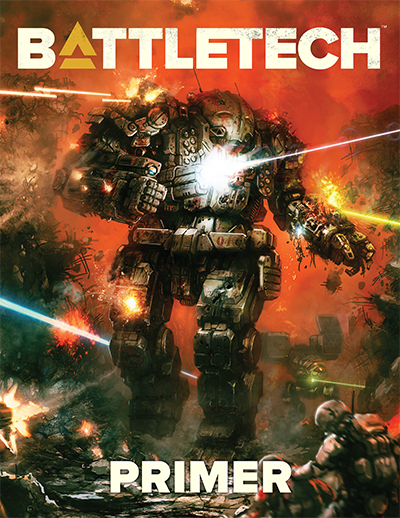 BattleTech is a science-fiction “space opera”: a factional, militarized universe set in the thirty-first century, a future where humanity has spread to the stars and spawned titanic interstellar empires, each nation controlling hundreds of worlds across a region of space stretching a thousand light years and beyond.
BattleTech is a science-fiction “space opera”: a factional, militarized universe set in the thirty-first century, a future where humanity has spread to the stars and spawned titanic interstellar empires, each nation controlling hundreds of worlds across a region of space stretching a thousand light years and beyond.
Initially published over thirty years ago as a tabletop board game, BattleTech has gone on to become one of the gaming industry’s most important and longest-lasting science-fiction universes.
Be sure to check out the latest BattleTech Releases and the Coming Soon page for the newest BattleTech products.

